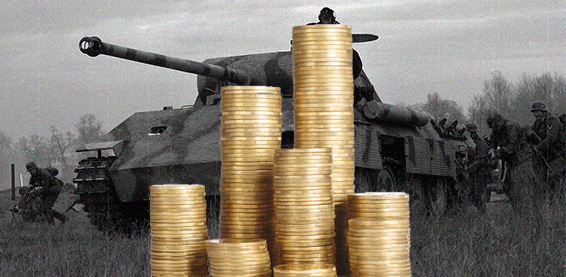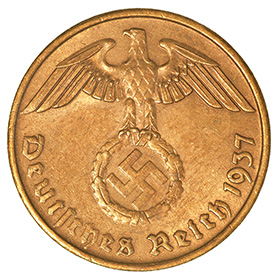
Some gold news stories serve as little more than a set of underlying numbers: a policy decision swings the price of gold up a few percentage points, or a mining company has a record output of ten tons at a single mine. Occasionally, however, some gold news is remarkable enough to make history come alive. A story out of Germany last week shows us how gold represents more than just a valuable commodity; a World War II era hoard of Nazi gold was found buried underground, which was likely a stash of the Third Reich’s coinage used to power Hitler’s economy.
Secret Stash of German Gold Uncovered
Last week, archaeologist Florian Bautsch discovered a German hoard of gold in Lüneburg, about 40 miles from Hamburg in the northern province. This stash represents one of the largest hoards discovered by amateur archeologists to date. The initial discovery of just ten coins, each stamped with the Nazi swastika and the insignia “Reichsbank Berlin,” led to an excavation of over two hundred coins buried deeper within the ground. All told, the collection is worth about 45,000 Euro, or just under $50,000, representing some 40 ounces of gold in total.

Historians hypothesize that since these coins appeared buried deep within the ground, an inside agent of the Nazi bank likely stole them, perhaps during the crisis of 1945 as the American army advanced on Germany from the west and the Soviet army conquered Berlin from the east. Each coin weighs 6 and a half grams and the collection has been described as in near-flawless condition. The coin collection will be put on display at the local Lüneburg museum with the suggestion that some coins may also be sold to the highest bidder, where history aficionados will certainly pay far more than the per-ounce price for a golden piece of World War II.
Gold in History
While Hollywood has used the “Nazi gold” plotline often enough for us to think it a myth, the German expansion across Europe did in fact involve the theft of huge quantities of resources. The German war machine had a plethora of base metals like copper and iron but lacked any significant quantities of precious metals. The Schutzstaffel, more commonly known as the SS, raided banks and private collections in order to come up with a steady stream of gold to send back to Berlin. During the Holocaust, furthermore, the “undesirable” populations of Jews, Gypsies, Poles, political prisoners, and communists had to surrender all their personal belongings, including gold jewelry and even gold fillings, prior to boarding the trains that sent them to labor camps and death camps.
By the conclusion of the war, the German economy had been so ravaged by shortages and labor that cash currency experienced hyperinflation, meaning that gold and silver represented the only viable means of purchasing so much as a single loaf of bread. While the Holocaust represented a very dark age of human history, these 200 gold coins, which were most likely confiscated from German prisoners, will now be put on public display—perhaps as a tangible reminder of the cost of intolerance and an inhumane government.

